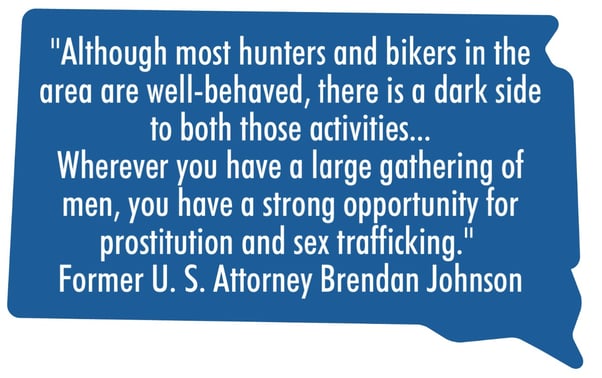South Dakota is most recognized for its open ranges, miles of lush farmland, and as the home of 1.2 million acres of the Black Hills National Forest. These same serene rolling hills and towering pines awaken with sounds of rumbling as they host the largest annual tourist attraction in the state every summer.
What is the Sturgis Motorcycle Rally?
Celebrating its 84th year, the Sturgis Motorcycle Rally attracts hundreds of thousands of motorcyclists from across the country to gather for the week-long rally, which runs officially from August 2-11. While most of these motorcyclists tour the natural beauty of the Black Hills, enjoy outdoor concerts, and spend their tourist dollars at vendor tents, local bars, and restaurants—there is also a disturbing reality taking place. Hidden in the shadows from the music and crowds, are DCI agents and other law enforcement officials standing vigil and conducting undercover sex sting operations.
Regrettably, the Sturgis rally has become a main event that drives human trafficking within the state of South Dakota. However, it’s not the only time the state sees human trafficking.

The two major interstates that run through the state, I-90 and I-29, are “part of the ‘Midwest Pipeline,’ the superhighways used to deliver trafficking victims to cities across the country, ” according to this fact sheet.
The reality is that whenever there is an event that attracts a large number of men, there is a market for some form of sex trafficking. And, while sex trafficking exists around the nation, there’s something distinctive about South Dakota. The peaceful, homegrown mentality that exists here has made it an excellent “cover” for sex trafficking.
he Dark Side of the Sturgis Motorcycle Rally
This is not an isolated issue; rather, it is a growing epidemic. The Division of Criminal Investigation has been conducting undercover sex stings in South Dakota for several years, even allowing KELOLAND News to be a part of the undercover operations in Sturgis.
Although there has been an agreement in place with the Attorney General’s office preventing them from showing the public all the operations’ details, the Attorney General feels strongly that bringing public awareness to the forefront of this horrific issue will make a difference in the fight against human trafficking.
“When you have large events like this, there’s a criminal element, and we’ve experienced in the past some child predators out and about in the community. We’ve taken it upon ourselves in law enforcement to do certain operations really to protect children.” – South Dakota Attorney General Marty Jackley
Protecting Native American women and children from sex trafficking
South Dakota is also home to 9 Native American reservations and designated tribal land areas…more than any other state. Native women and children are at higher risk for trafficking than any other racial group. According to the U.S. Attorney’s Office, more than 40% of those trafficked in the state have been Native women. What’s even more startling is that only 8% of South Dakota’s residents are Native.
While it can happen to anyone, Native American women and children are at a higher risk. Traffickers often exploit the needs of potential victims, whether they are fundamental physical requirements like shelter and food, or emotional needs such as affection and a sense of belonging. According to the Polaris Project, “Generational trauma, historic oppression, discrimination, and other societal factors and inequities create community-wide vulnerabilities.”
These women and children will often spend a lifetime trying to heal from this horrific abuse. Native Hope spoke with a sex trafficking victim who was able to find her way out. She acknowledged the devastating effects of her past by saying, “I wonder just how aware the people who commit these crimes are of the damage made.”
Raising awareness impacts the lives of vulnerable individuals to ensure that nobody experiences hardship while seeking basic human necessities. It requires a collective effort to safeguard the needs and rights of all members within our communities.
Sturgis Motorcycle Rally Statistics
In the past few years alone:
How to recognize the signs of sex trafficking
If some of these signs are present, they may indicate something is wrong:
- Avoids eye contact and seems fearful
- Not allowed or able to speak for himself/herself
- Anxious, especially around law enforcement
- Can’t say where he/she is staying
- Has numerous inconsistencies in his/her story
- Shows signs of mental or physical abuse
Help End Human Trafficking
Partnering with the West River Human Trafficking Task Force, Ellsworth Airforce Base, the South Dakota Network Against Family Violence and Sexual Assault, the Sturgis Police, and the Pennington County Sheriff’s Department, Native Hope is determined to end the trafficking of Native Americans. But we can’t do it without you. Together, we can be a powerful force in raising awareness and ending this dark industry.
Learn the signs and how to report human trafficking. If you see something, say something.
- If you or someone you know is being trafficked or assaulted, call 911 so local law enforcement can respond immediately.
- If a person needs to reach out and talk to someone, please call the 24-hour SD Statewide Sex Trafficking & Sexual Assault Victim Hotline at 1 (888) 352-8511 or 211.


